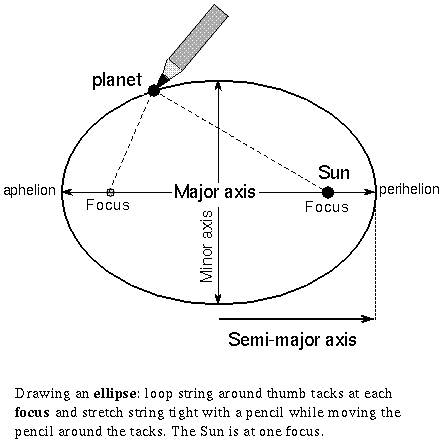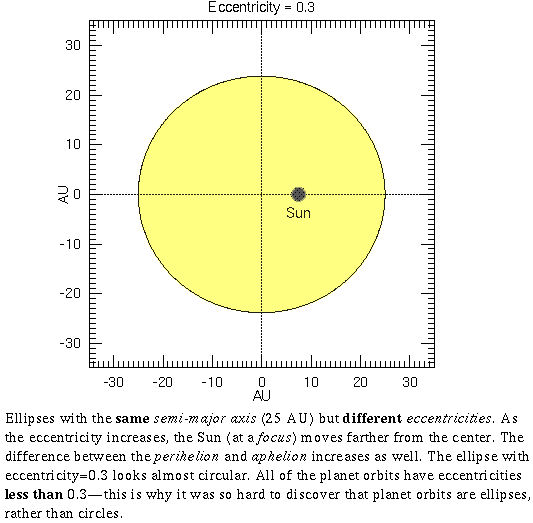This material (including images) is copyrighted!.
See my copyright notice for fair use
practices. Select the photographs to display the original source in
another window.
 Johaness Kepler (lived 1571--1630 C.E.) was hired
by Tycho Brahe to work out the mathematical details of Tycho's version of the
geocentric universe. Kepler was a religious
individualist. He did not go along with the Roman Catholic Church or the
Lutherans. He had an ardent mystical neoplatonic faith. He wanted to work with
the best observational data available because he felt that even the most elegant,
mathematically-harmonious theories must match reality. Kepler was motivated by his
faith in
God to try to discover God's plan in the universe---to ``read the mind of God.''
Kepler shared the Greek view that mathematics was the language of God. He knew that
all previous models were inaccurate, so he believed that other scientists had not
yet ``read the mind of God.''
Johaness Kepler (lived 1571--1630 C.E.) was hired
by Tycho Brahe to work out the mathematical details of Tycho's version of the
geocentric universe. Kepler was a religious
individualist. He did not go along with the Roman Catholic Church or the
Lutherans. He had an ardent mystical neoplatonic faith. He wanted to work with
the best observational data available because he felt that even the most elegant,
mathematically-harmonious theories must match reality. Kepler was motivated by his
faith in
God to try to discover God's plan in the universe---to ``read the mind of God.''
Kepler shared the Greek view that mathematics was the language of God. He knew that
all previous models were inaccurate, so he believed that other scientists had not
yet ``read the mind of God.''
Since an infinite number of models are possible (see
Plato's Instrumentalism above),
he had to choose one as a starting point. Although he was
hired by Tycho to work on Tycho's geocentric model, Kepler did not believe in
either Tycho's model or Ptolemy's model (he thought Ptolemy's model was
mathematically ugly). His neoplatonic faith led him to choose Copernicus'
heliocentric model over his employer's model
Kepler tried to refine Copernicus' model. After
years of failure, he was
finally convinced with great reluctance of an revolutionary idea: God uses a
different mathematical
shape than the circle. This idea went against the 2,000 year-old Pythagorean
paradigm of the perfect shape being a circle! Kepler had a hard time convincing
himself that planet orbits are not circles and his contemporaries, including the
great scientist Galileo, disagreed with Kepler's conclusion. He discovered
that planetary orbits
are ellipses with the Sun at one focus. This is now known as Kepler's
1st law.

An ellipse is a
squashed circle that can be drawn by punching two thumb tacks into some paper,
looping a string around the tacks, stretching the string with a pencil, and moving
the pencil around the tacks while keeping the string taut. The figure traced out
is an ellipse and the thumb tacks are at the two foci of the ellipse. An oval shape
(like an egg) is not an ellipse: an oval tapers at one end, but an ellipse is
tapered at both ends (Kepler had tried oval shapes but he found they did not work).
There are some terms I will use frequently in the rest of
this book that are used in discussing any sort of orbit. Here is a list of
definitions:
- Major axis---the length of the longest dimension of an ellipse.
- Semi-major axis---one half of the major axis and equal to the distance
from the center of the ellipse to one end of the ellipse. It is also the average
distance of a planet from the Sun at one focus.
- Minor axis---the length of the shortest dimension of an ellipse.
- Perihelion---point on a planet's orbit that is closest to the Sun. It
is on the major axis.
- Aphelion---point on a planet orbit that is farthest from the Sun. It
is on the major axis directly opposite the perihelion point. The aphelion +
perihelion = the major axis.
- Focus---one of two special points along the major axis such that the
distance
between it and any point on the ellipse + the distance between the other focus
and the same point on the ellipse is always the same value. The Sun is at one of
the two foci (nothing is at the other one). The Sun is NOT at the center of the
orbit!
As the foci are moved farther apart from each other, the ellipse becomes more
eccentric (skinnier). See the figure below.
A circle is a special form of an ellipse that has the two foci at the same
point (the center of the ellipse).
- The eccentricity (e) of an ellipse is a number that
quantifies how elongated the ellipse is. It equals 1 -
(perihelion)/(semi-major axis). Circles have an eccentricity = 0; very long and
skinny ellipses have an eccentricity close to 1 (a straight line has an
eccentricity = 1).
The skinniness an ellipse is specified by the semi-minor axis. It equals the
semi-major axis ×
Sqrt[(1 - e2)].
Planet orbits have small eccentricities (nearly circular orbits) which is why
astronomers before Kepler thought the orbits were exactly circular. This slight
error in the orbit shape accumulated into a large error in planet positions after
a few hundred years. Only very
accurate and precise observations can show the elliptical character of the orbits.
Tycho's observations, therefore, played a key role in Kepler's discovery and is an
example of a fundamental breakthrough in our understanding of the universe being
possible only from greatly improved observations of the universe.

Most comet orbits have large eccentricities (some are so eccentric that the
aphelion is around 100,000 AU while the perihelion is less than 1 AU!).
The figure above illustrates how the shape of an ellipse depends on the
semi-major axis and the eccentricity. The eccentricity of
the ellipses increases from top left to bottom left in a counter-clockwise direction
in the figure but the semi-major axis remains the same. Notice where the Sun
is for each of the orbits. As the eccentricity increases, the Sun's position is closer
to one side of the elliptical orbit, but the semi-major axis remains the same.
To account for the planets' motion (particularly Mars') among
the stars,
Kepler found that the planets must move around the Sun at a variable speed.
When the planet is close to perihelion, it moves quickly; when
it is close to aphelion, it moves slowly. This was another break with the
Pythagorean paradigm of uniform motion! Kepler discovered another rule of
planet orbits: a line between the planet and the Sun sweeps out equal areas
in equal times. This is now known as Kepler's 2nd law.
Later, scientists found that this is a
consequence of the conservation of
angular momentum.
The angular
momentum of a planet is a measure of the amount of orbital motion it has and does
NOT change as the planet orbits the Sun. It equals
the (planet mass) × (planet's transverse speed) × (distance from the Sun).
The transverse speed is the
amount of the planet's orbital velocity that is in the direction perpendicular to
the line between the planet and the Sun. If the distance
decreases, then the speed must increase to compensate; if the distance increases,
then the speed decreases (a planet's mass does not change).
Finally, after several more years of
calculations, Kepler found a simple, elegant equation relating the distance of
a planet from the Sun to how long it takes to orbit the Sun (the planet's sidereal
period). (One planet's sidereal period/another planet's sidereal
period)2
= (one planet's average distance from Sun/another planet's average distance
from Sun)3. If you compare the
planets to the Earth (with an orbital period = 1 year and a distance = 1 A.U.), then you
get a very simple relation: (a planet's sidereal period in years)2
= (semimajor axis of its orbit in A.U.)3. This is now known as
Kepler's 3rd law. A review of exponents and square roots is
available in the mathematics
review appendix.
For example, Mars' orbit has a semi-major axis of 1.52 A.U., so 1.523
= 3.51 and this equals 1.872. The number 1.87 is the number of years it
takes Mars to go around the Sun.
This simple mathematical
equation explained all of the observations throughout history and proved to Kepler
that the heliocentric system is real. Actually, the first two laws were sufficient,
but the third law was very important for Isaac Newton and is used today to determine the
masses of many different types of celestial objects. Kepler's third law has many uses
in astronomy! Although Kepler derived these
laws for the motions of the planets around the Sun, they are found to be true for any
object orbiting any other object. The fundamental nature of these rules and their
wide applicability is why they are considered ``laws'' of nature.

Select the image to show an animation of Kepler's 3 laws.
A nice java
applet for Kepler's laws is available on the web (select the link to
view it in another window).
Vocabulary
| angular momentum | aphelion | eccentricity |
| ellipse | focus | Kepler's 1st law |
| Kepler's 2nd law | Kepler's 3rd law | perihelion |
| semi-major axis |
- What shape are planet orbits and where is the Sun with respect to the orbit?
- What happens to a planet's orbital speed as it
approaches its farthest point from the Sun and as it approaches its
closest point? How is it related to angular momentum?
- How were Kepler's laws of planetary motion revolutionary or a radical break
from earlier descriptions of planetary motion?
- A moon's closest distance from a planet is 300,000 km and its farthest
distance is 500,000 km. What is the semi-major axis of its elliptical
orbit?
- How will the semi-minor axis compare with the semi-major axis for an ellipse
with eccentricity = 0.1, 0.5, 0.8, 0.99? Find the value of (semi-minor/semi-major) for
each of the eccentricities.
- How will the perihelion compare with the aphelion for an ellipse with
eccentricity = 0.1, 0.5, 0.8, 0.99? Find the value of (perihelion/aphelion) for each
of the eccentricities. [Hint: using the relation that the perihelion + aphelion =
2× semi-major axis and a little algebra, you can find that (perihelion/aphelion) =
(1-e)/(1+e).]
- How is the average distance between a planet and the Sun related to the
planet's orbit period?
- Which planet has a shorter period---one with a large average distance, or
one with a small average distance?
- What is the semi-major axis of an asteroid orbiting the Sun with a period of
64 years? (Kepler's third law works for any object orbiting the Sun.)
 Go back to previous section --
Go back to previous section --
 Go to next section
Go to next section
last updated: 28 May 2001
Is this page a copy of Strobel's
Astronomy Notes?
Author of original content:
Nick Strobel
 Johaness Kepler (lived 1571--1630 C.E.) was hired
by Tycho Brahe to work out the mathematical details of Tycho's version of the
geocentric universe. Kepler was a religious
individualist. He did not go along with the Roman Catholic Church or the
Lutherans. He had an ardent mystical neoplatonic faith. He wanted to work with
the best observational data available because he felt that even the most elegant,
mathematically-harmonious theories must match reality. Kepler was motivated by his
faith in
God to try to discover God's plan in the universe---to ``read the mind of God.''
Kepler shared the Greek view that mathematics was the language of God. He knew that
all previous models were inaccurate, so he believed that other scientists had not
yet ``read the mind of God.''
Johaness Kepler (lived 1571--1630 C.E.) was hired
by Tycho Brahe to work out the mathematical details of Tycho's version of the
geocentric universe. Kepler was a religious
individualist. He did not go along with the Roman Catholic Church or the
Lutherans. He had an ardent mystical neoplatonic faith. He wanted to work with
the best observational data available because he felt that even the most elegant,
mathematically-harmonious theories must match reality. Kepler was motivated by his
faith in
God to try to discover God's plan in the universe---to ``read the mind of God.''
Kepler shared the Greek view that mathematics was the language of God. He knew that
all previous models were inaccurate, so he believed that other scientists had not
yet ``read the mind of God.''


